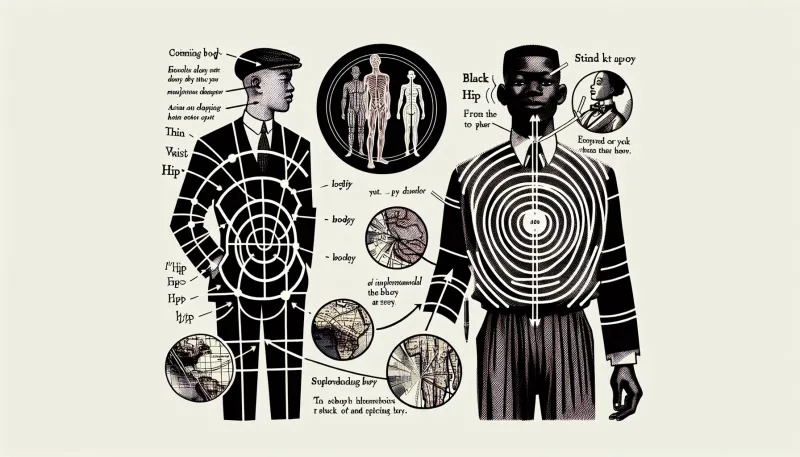Understanding Waist-to-Hip Ratio and Body Shape: A Comprehensive Guide

Discover the significance of waist-to-hip ratio and body shape for overall health. Learn how to measure, interpret, and improve your ratio for better well-being.
Introduction
The waist-to-hip ratio (WHR) and body shape are crucial indicators of overall health and fitness. While many people focus on weight and body mass index (BMI), WHR provides significant insights into the risk of health conditions such as cardiovascular diseases, diabetes, and metabolic syndrome. This comprehensive guide delves into the importance of WHR and body shape, offering valuable information on how to measure, interpret, and improve this ratio for optimal health.
What is Waist-to-Hip Ratio?
The waist-to-hip ratio is a numerical measurement that compares the circumference of your waist to that of your hips. It is calculated by dividing the waist circumference by the hip circumference, producing a single value that helps identify potential health risks.
Importance of Waist-to-Hip Ratio
Health Implications
Studies have shown that a higher WHR indicates a greater risk of conditions such as:
- Cardiovascular diseases
- Type 2 diabetes
- Metabolic syndrome
- Stroke
A lower WHR generally corresponds to a lower risk of these health issues, making it an essential metric for assessing overall wellness.
How to Measure Your Waist-to-Hip Ratio
Step-By-Step Guide
Measuring your WHR accurately requires just a measuring tape and a few simple steps:
- Measure your waist circumference at the narrowest point, typically just above the belly button.
- Measure your hip circumference at the widest part of your hips and buttocks.
- Divide the waist circumference by the hip circumference to get your WHR.
For example, if your waist measurement is 30 inches and your hip measurement is 40 inches, your WHR would be 0.75 (30 ÷ 40 = 0.75).
Interpreting Waist-to-Hip Ratio
The interpretation of WHR values varies between men and women due to natural differences in body composition:
For Women
- Low Risk: WHR ≤ 0.80
- Moderate Risk: WHR 0.81 to 0.85
- High Risk: WHR ≥ 0.86
For Men
- Low Risk: WHR ≤ 0.90
- Moderate Risk: WHR 0.91 to 0.95
- High Risk: WHR ≥ 0.96
Waist-to-Hip Ratio and Body Shape
Understanding Body Shapes
The WHR is closely linked to different body shapes, which can also provide insights into health conditions. Common body shapes include:
- Apple: Characterized by a larger waist circumference compared to hips.
- Pear: Characterized by wider hips compared to waist.
- Hourglass: Proportionate waist and hip measurements with a visibly smaller waist.
- Rectangle: Similar waist and hip measurements, creating a straight silhouette.
Health Risks by Body Shape
Apple-shaped individuals are often at a higher risk for metabolic and cardiovascular diseases due to fat accumulation around the abdomen. In contrast, pear-shaped individuals tend to store fat in the lower body, which poses a lower risk for these conditions. Understanding your body shape alongside your WHR can help tailor a more effective health and fitness plan.
How to Improve Your Waist-to-Hip Ratio
Dietary Changes
Adopting a balanced diet rich in whole foods can aid in improving your WHR. Consider incorporating:
- Fruits and vegetables
- Whole grains
- Lean proteins
- Healthy fats
Avoid excessive consumption of processed foods, sugary beverages, and high-fat snacks.
Exercise and Physical Activity
Regular physical activity is crucial in maintaining a healthy WHR. Effective exercises include:
- Cardiovascular activities such as running, cycling, and swimming
- Strength training to build muscle mass and tone the body
- Core exercises to specifically target abdominal fat
A combined approach of aerobic and resistance exercises is the most effective way to reduce waist circumference and improve overall body composition.
Lifestyle Modifications
Healthy lifestyle choices play a significant role in improving WHR. Prioritize:
- Adequate sleep
- Stress management techniques like meditation and yoga
- Hydration by drinking plenty of water
Such habits support overall well-being, contributing to a healthier waist-to-hip ratio.
Conclusion
Understanding and monitoring your waist-to-hip ratio is a critical component of maintaining optimal health. This guide has provided essential insights into the importance of WHR, how to measure and interpret it, the relationship with body shape, and effective strategies to improve this ratio. By integrating these practices into your lifestyle, you can better manage your health risks and achieve long-term wellness.



























